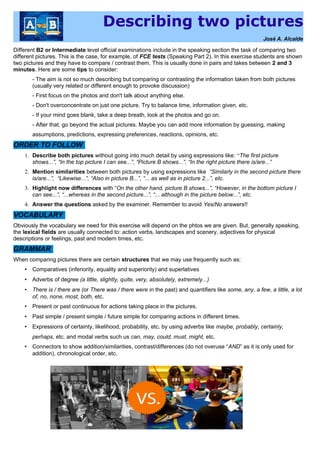
Describing two pictures
- 1. Describing two pictures José A. Alcalde Different B2 or Intermediate level official examinations include in the speaking section the task of comparing two different pictures. This is the case, for example, of FCE tests (Speaking Part 2). In this exercise students are shown two pictures and they have to compare / contrast them. This is usually done in pairs and takes between 2 and 3 minutes. Here are some tips to consider: - The aim is not so much describing but comparing or contrasting the information taken from both pictures (usually very related or different enough to provoke discussion) - First focus on the photos and don't talk about anything else. - Don't overconcentrate on just one picture. Try to balance time, information given, etc. - If your mind goes blank, take a deep breath, look at the photos and go on. - After that, go beyond the actual pictures. Maybe you can add more information by guessing, making assumptions, predictions, expressing preferences, reactions, opinions, etc. ORDER TO FOLLOW 1. Describe both pictures without going into much detail by using expressions like: “The first picture shows...”, “In the top picture I can see...”, “Picture B shows...”, “In the right picture there is/are...” 2. Mention similarities between both pictures by using expressions like “Similarly in the second picture there is/are...”, “Likewise...”, “Also in picture B...”, “... as well as in picture 2...”, etc. 3. Highlight now differences with “On the other hand, picture B shows...”, “However, in the bottom picture I can see...”, “...whereas in the second picture...”, “... although in the picture below...”, etc. 4. Answer the questions asked by the examiner. Remember to avoid Yes/No answers!! VOCABULARY Obviously the vocabulary we need for this exercise will depend on the phtos we are given. But, generally speaking, the lexical fields are usually connected to: action verbs, landscapes and scenery, adjectives for physical descriptions or feelings, past and modern times, etc. GRAMMAR When comparing pictures there are certain structures that we may use frequently such as: • Comparatives (inferiority, equality and superiority) and superlatives • Adverbs of degree (a little, slightly, quite, very, absolutely, extremely...) • There is / there are (or There was / there were in the past) and quantifiers like some, any, a few, a little, a lot of, no, none, most, both, etc. • Present or past continuous for actions taking place in the pictures. • Past simple / present simple / future simple for comparing actions in different times. • Expressions of certainty, likelihood, probability, etc. by using adverbs like maybe, probably, certainly, perhaps, etc. and modal verbs such us can, may, could, must, might, etc. • Connectors to show addition/similarities, contrast/differences (do not overuse “AND” as it is only used for addition), chronological order, etc.
